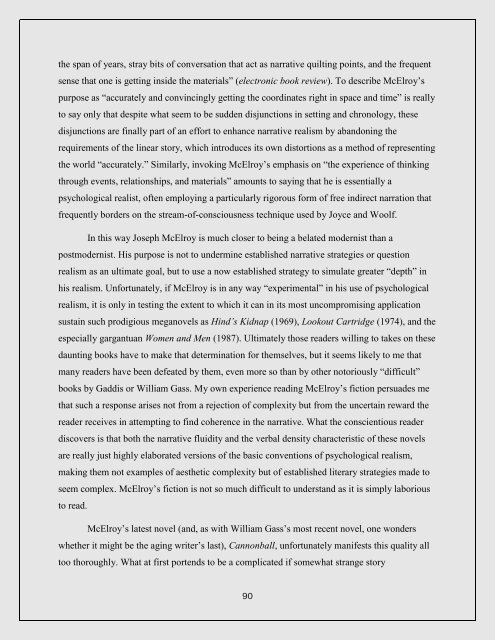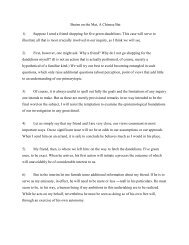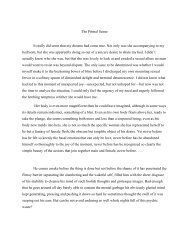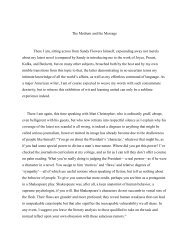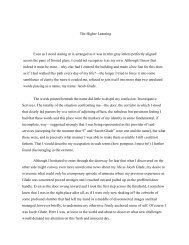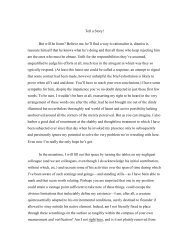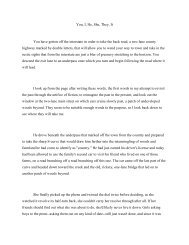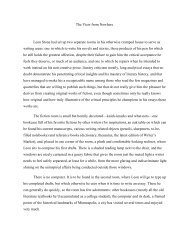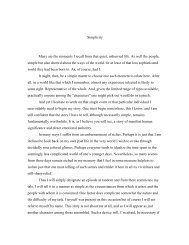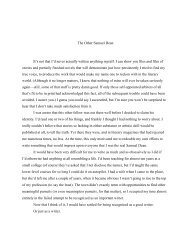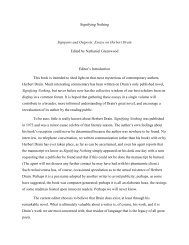APF
Create successful ePaper yourself
Turn your PDF publications into a flip-book with our unique Google optimized e-Paper software.
the span of years, stray bits of conversation that act as narrative quilting points, and the frequent<br />
sense that one is getting inside the materials” (electronic book review). To describe McElroy’s<br />
purpose as “accurately and convincingly getting the coordinates right in space and time” is really<br />
to say only that despite what seem to be sudden disjunctions in setting and chronology, these<br />
disjunctions are finally part of an effort to enhance narrative realism by abandoning the<br />
requirements of the linear story, which introduces its own distortions as a method of representing<br />
the world “accurately.” Similarly, invoking McElroy’s emphasis on “the experience of thinking<br />
through events, relationships, and materials” amounts to saying that he is essentially a<br />
psychological realist, often employing a particularly rigorous form of free indirect narration that<br />
frequently borders on the stream-of-consciousness technique used by Joyce and Woolf.<br />
In this way Joseph McElroy is much closer to being a belated modernist than a<br />
postmodernist. His purpose is not to undermine established narrative strategies or question<br />
realism as an ultimate goal, but to use a now established strategy to simulate greater “depth” in<br />
his realism. Unfortunately, if McElroy is in any way “experimental” in his use of psychological<br />
realism, it is only in testing the extent to which it can in its most uncompromising application<br />
sustain such prodigious meganovels as Hind’s Kidnap (1969), Lookout Cartridge (1974), and the<br />
especially gargantuan Women and Men (1987). Ultimately those readers willing to takes on these<br />
daunting books have to make that determination for themselves, but it seems likely to me that<br />
many readers have been defeated by them, even more so than by other notoriously “difficult”<br />
books by Gaddis or William Gass. My own experience reading McElroy’s fiction persuades me<br />
that such a response arises not from a rejection of complexity but from the uncertain reward the<br />
reader receives in attempting to find coherence in the narrative. What the conscientious reader<br />
discovers is that both the narrative fluidity and the verbal density characteristic of these novels<br />
are really just highly elaborated versions of the basic conventions of psychological realism,<br />
making them not examples of aesthetic complexity but of established literary strategies made to<br />
seem complex. McElroy’s fiction is not so much difficult to understand as it is simply laborious<br />
to read.<br />
McElroy’s latest novel (and, as with William Gass’s most recent novel, one wonders<br />
whether it might be the aging writer’s last), Cannonball, unfortunately manifests this quality all<br />
too thoroughly. What at first portends to be a complicated if somewhat strange story<br />
90


